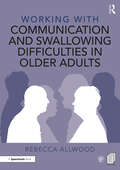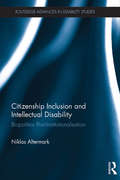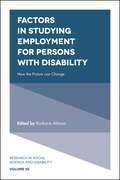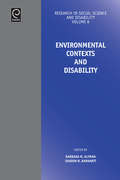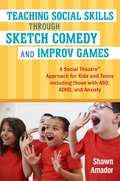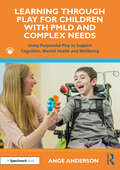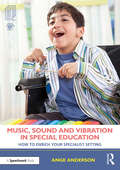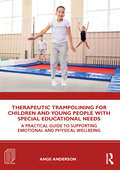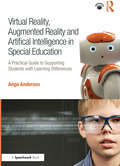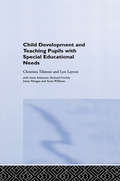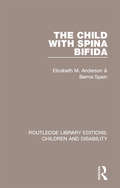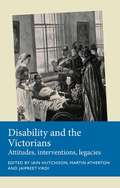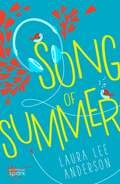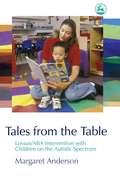- Table View
- List View
Working with Communication and Swallowing Difficulties in Older Adults (Working With)
by Rebecca AllwoodThis accessible resource offers valuable guidance for all student and practising speech and language therapists (SLTs)who are working with older people with communication and swallowing difficulties. Chapters provide up-to-date theory on age-related changes alongside practical strategies for clinicians to use in their daily work, from help with mental capacity decisions to supporting older people with good palliative care. Promoting a holistic approach for ageing well, this resource dispels myths that surround the ageing process while detailing the normal physiological and psychological effects of ageing on communication and swallowing, as well as diseases and conditions associated with older age, such as frailty. Illustrated throughout with clinical case studies and helpful photocopiable resources to use in practice, this book is a key part of the tool kit for any speech and language therapist working with older adults.
Working with Communication and Swallowing Difficulties in Older Adults (Working With)
by Rebecca AllwoodThis accessible resource offers valuable guidance for all student and practising speech and language therapists (SLTs)who are working with older people with communication and swallowing difficulties. Chapters provide up-to-date theory on age-related changes alongside practical strategies for clinicians to use in their daily work, from help with mental capacity decisions to supporting older people with good palliative care. Promoting a holistic approach for ageing well, this resource dispels myths that surround the ageing process while detailing the normal physiological and psychological effects of ageing on communication and swallowing, as well as diseases and conditions associated with older age, such as frailty. Illustrated throughout with clinical case studies and helpful photocopiable resources to use in practice, this book is a key part of the tool kit for any speech and language therapist working with older adults.
Citizenship Inclusion and Intellectual Disability: Biopolitics Post-Institutionalisation (Routledge Advances in Disability Studies)
by Niklas AltermarkWhat happens when a group traditionally defined as lacking the necessary capacities of citizenship is targeted by government programs that have made ‘citizenship inclusion’ their main goal? Combining theoretical perspectives of political philosophy, social theory, and disability studies, this book untangles the current state of Western intellectual disability politics following the replacement of state institutionalisation by independent and supported living, individual rights, and self-determination. Taking its cue from Foucault’s conception of ‘biopolitics’, denoting the government of the individuals and the totality of the population, its overarching argument is that the ambiguous positioning of people with intellectual disabilities with respect to the ideals of citizenship results in a regime of government that simultaneously includes and excludes people of this group. On the one hand, its members are projected to become ideal-citizens via the cultivation of citizenship capacities. On the other, the right to live independently and by their own choices is curtailed as soon as they are seen as failing with respect to the ideals of reason and rationality. Therefore, coercion, restraints, and paternalism, which were all supposed to end with deinstitutionalisation, are still ingrained in services targeting the group. In equal parts a theoretical work, advancing debates of critical disability theory, social theory, and post-structural philosophy, as well as an empirical engagement with the history of intellectual disability politics and the ways in which present day politics target the group, this book will be of interest to all students and scholars of disability studies, disability politics, and political theory.
Citizenship Inclusion and Intellectual Disability: Biopolitics Post-Institutionalisation (Routledge Advances in Disability Studies)
by Niklas AltermarkWhat happens when a group traditionally defined as lacking the necessary capacities of citizenship is targeted by government programs that have made ‘citizenship inclusion’ their main goal? Combining theoretical perspectives of political philosophy, social theory, and disability studies, this book untangles the current state of Western intellectual disability politics following the replacement of state institutionalisation by independent and supported living, individual rights, and self-determination. Taking its cue from Foucault’s conception of ‘biopolitics’, denoting the government of the individuals and the totality of the population, its overarching argument is that the ambiguous positioning of people with intellectual disabilities with respect to the ideals of citizenship results in a regime of government that simultaneously includes and excludes people of this group. On the one hand, its members are projected to become ideal-citizens via the cultivation of citizenship capacities. On the other, the right to live independently and by their own choices is curtailed as soon as they are seen as failing with respect to the ideals of reason and rationality. Therefore, coercion, restraints, and paternalism, which were all supposed to end with deinstitutionalisation, are still ingrained in services targeting the group. In equal parts a theoretical work, advancing debates of critical disability theory, social theory, and post-structural philosophy, as well as an empirical engagement with the history of intellectual disability politics and the ways in which present day politics target the group, this book will be of interest to all students and scholars of disability studies, disability politics, and political theory.
Factors in Studying Employment for Persons with Disability: How the Picture can Change (Research in Social Science and Disability #10)
by Barbara AltmanThe current literature regarding employment among persons with disabilities produces research results dependent on definitions of work disability, the discipline within which research takes places, the model or paradigm of disability in which the research is framed, the methodology and measures used and the cultural context in which employment occurs. This volume seeks to address those factors which have made describing, predicting and examining the work experience of a person with a disability both different and difficult. Contributors examine less frequently anaylzed aspects of employment for persons with disabilities, and offer a variety of approaches to the conceptualization of work, how they differ across cultures, organizations, and types of disability. Topics covered include examination of range of contextual framing of employment for those with disabilities, well-being, the impact of gender, poverty and education and the collection concludes by examining the future of employment developments and trends and the impacts on inclusion of people with disabilities in the paid workforce.
Factors in Studying Employment for Persons with Disability: How the Picture can Change (Research in Social Science and Disability #10)
by Barbara AltmanThe current literature regarding employment among persons with disabilities produces research results dependent on definitions of work disability, the discipline within which research takes places, the model or paradigm of disability in which the research is framed, the methodology and measures used and the cultural context in which employment occurs. This volume seeks to address those factors which have made describing, predicting and examining the work experience of a person with a disability both different and difficult. Contributors examine less frequently anaylzed aspects of employment for persons with disabilities, and offer a variety of approaches to the conceptualization of work, how they differ across cultures, organizations, and types of disability. Topics covered include examination of range of contextual framing of employment for those with disabilities, well-being, the impact of gender, poverty and education and the collection concludes by examining the future of employment developments and trends and the impacts on inclusion of people with disabilities in the paid workforce.
Environmental Contexts and Disability (Research in Social Science and Disability #8)
by Barbara Altman Sharon N. BarnarttPhysical structure, economic expectation or social relationship norms developed within various cultures can either restrict or support the participation of individuals with disabilities in society. The influence of environmental factors can vary significantly according to context, characteristics or by action difficulty. The objective of this volume is to identify and address environmental issues that support or restrict the participation of persons with functional limitations in society, either at the micro, meso or macro levels. The papers address both individual, societal, national and international levels of environment and shed new light on the processes involved with creating or modifying these environmental supports or barriers. Several papers approach the societal and intra-societal levels. The volume is separated into four parts; part one focuses on the larger disability environment from an international, national and community perspective, the second includes important theoretical and methodological approaches; section three highlights reviews of the environmental literature and the final section addresses personal experience with environmental barriers.
Teaching Social Skills Through Sketch Comedy and Improv Games: A Social Theatre™ Approach for Kids and Teens including those with ASD, ADHD, and Anxiety
by Shawn AmadorIntroducing a Social Theatre™, this book provides guidance on how to deliver fun and transformative activities to develop social skills in teenagers and children. Drawing on ideas from Social Thinking®, CBT, mindfulness and assertiveness training this book develops games, skits and short plays which can be adapted to suit children and teenagers including those who are gifted, typical, and those with mild to moderate cognitive abilities. These activities will help participants become more assertive and flexible as well as improving confidence, focus and self-esteem. Social Theatre™ can be used in small groups, in class or throughout the school, as well as in group therapy sessions. It provides a new and inclusive way to teach social skills and collaborative learning and is especially useful for those with anxiety, ADHD and ASD.
Teaching Social Skills Through Sketch Comedy and Improv Games: A Social Theatre® Approach For Kids And Teens Including Those With Asd, Adhd, And Anxiety
by Shawn AmadorIntroducing a Social Theatre™, this book provides guidance on how to deliver fun and transformative activities to develop social skills in teenagers and children. Drawing on ideas from Social Thinking®, CBT, mindfulness and assertiveness training this book develops games, skits and short plays which can be adapted to suit children and teenagers including those who are gifted, typical, and those with mild to moderate cognitive abilities. These activities will help participants become more assertive and flexible as well as improving confidence, focus and self-esteem. Social Theatre™ can be used in small groups, in class or throughout the school, as well as in group therapy sessions. It provides a new and inclusive way to teach social skills and collaborative learning and is especially useful for those with anxiety, ADHD and ASD.
Learning Through Play for Children with PMLD and Complex Needs: Using Purposeful Play to Support Cognition, Mental Health and Wellbeing
by Ange AndersonThis book examines the development of play skills and schemas to support children with learning differences and physical disabilities in learning to play. It highlights the need for appropriate playground equipment in all school settings that educate children with physical disabilities and sensory needs to ensure equal opportunities for outdoor play. Several play approaches for meeting sensory needs are discussed including Lego therapy, Art therapy, Sand play and Soft play. Digital play for students with physical disabilities is an important chapter in the book. Role play and the ways in which virtual reality and psychodrama support anxieties that some students have is another important chapter. There is also a chapter devoted to parents on how they can support their child at home and how the school can support them. At the end of the book there is a plethora of resources that readers can copy or adapt to suit their setting. The book provides support for those managing outdoor play for these children at peak times of the day. It shows how play-based learning can work in a classroom setting; the importance of sensory profiles and sensory play; and how play therapy can aid neuroplasticity.
Learning Through Play for Children with PMLD and Complex Needs: Using Purposeful Play to Support Cognition, Mental Health and Wellbeing
by Ange AndersonThis book examines the development of play skills and schemas to support children with learning differences and physical disabilities in learning to play. It highlights the need for appropriate playground equipment in all school settings that educate children with physical disabilities and sensory needs to ensure equal opportunities for outdoor play. Several play approaches for meeting sensory needs are discussed including Lego therapy, Art therapy, Sand play and Soft play. Digital play for students with physical disabilities is an important chapter in the book. Role play and the ways in which virtual reality and psychodrama support anxieties that some students have is another important chapter. There is also a chapter devoted to parents on how they can support their child at home and how the school can support them. At the end of the book there is a plethora of resources that readers can copy or adapt to suit their setting. The book provides support for those managing outdoor play for these children at peak times of the day. It shows how play-based learning can work in a classroom setting; the importance of sensory profiles and sensory play; and how play therapy can aid neuroplasticity.
Music, Sound and Vibration in Special Education: How to Enrich Your Specialist Setting
by Ange AndersonThis book provides practical guidance on how to successfully incorporate music, sound and vibration into your special school, exploring the rich benefits that musical opportunities offer for children with physical, mental health and learning disabilities. Music has been shown to improve mood, lift depression, improve blood flow and even ease pain, whilst musical interventions can encourage communication and enable relaxation. This book explores the physical, cognitive and mental health benefits of music use in special schools, introducing therapies and innovations that can be adapted for use in your own specialist setting. Key features include: • Chapters exploring a range of music therapies and technologies that allow all students to access the benefits of music, sound and vibration, from one-to-one therapeutic music sessions to vibro-acoustic therapy and sing and sign • Case studies and anecdotes showcasing the innovative ways that special schools are using music, and providing concrete examples of how to deliver, record and access music provision • Photocopiable policies, risk assessments and links to useful resources Written by an author with a wealth of experience in special education, this book is essential reading for all those working in specialist settings or with children with SEND.
Music, Sound and Vibration in Special Education: How to Enrich Your Specialist Setting
by Ange AndersonThis book provides practical guidance on how to successfully incorporate music, sound and vibration into your special school, exploring the rich benefits that musical opportunities offer for children with physical, mental health and learning disabilities. Music has been shown to improve mood, lift depression, improve blood flow and even ease pain, whilst musical interventions can encourage communication and enable relaxation. This book explores the physical, cognitive and mental health benefits of music use in special schools, introducing therapies and innovations that can be adapted for use in your own specialist setting. Key features include: • Chapters exploring a range of music therapies and technologies that allow all students to access the benefits of music, sound and vibration, from one-to-one therapeutic music sessions to vibro-acoustic therapy and sing and sign • Case studies and anecdotes showcasing the innovative ways that special schools are using music, and providing concrete examples of how to deliver, record and access music provision • Photocopiable policies, risk assessments and links to useful resources Written by an author with a wealth of experience in special education, this book is essential reading for all those working in specialist settings or with children with SEND.
Therapeutic Trampolining for Children and Young People with Special Educational Needs: A Practical Guide to Supporting Emotional and Physical Wellbeing
by Ange AndersonThis practical resource explores the benefits of therapeutic trampolining on children and young people with special educational needs. It supports practitioners as they introduce the trampoline into their own therapeutic settings. Trampolining is known to improve balance, co-ordination and motor skills; it can improve bone density and benefit the lymphatic and cardiovascular systems. It has even shown to encourage communication in children with autism and PMLD. This book draws on the author’s extensive experience of delivering both the British Gymnastics Trampoline Proficiency Award scheme as well as the Rebound Therapy trampolining programme. The book also explores the practical side on how to set up and deliver trampolining as a therapy in schools, clubs or in the home. Photocopiable material includes: Lesson equipment, such as schemes of work, lesson plans adapted for varying needs and a trampoline rules poster. Tools for offering therapeutic trampolining sessions such as sequencing cards, communication cards, Risk Assessment, an individual education plan and a communication placemat. All the necessary forms to ensure a safe trampolining environment for all participants, including screening forms, referral and assessment forms and relevant policies. A business plan for after school provision, advertising leaflet and service level agreement. This is an invaluable resource for anybody looking to explore therapeutic trampolining as a way of enhancing the physical and emotional wellbeing of children and young people with special educational needs.
Therapeutic Trampolining for Children and Young People with Special Educational Needs: A Practical Guide to Supporting Emotional and Physical Wellbeing
by Ange AndersonThis practical resource explores the benefits of therapeutic trampolining on children and young people with special educational needs. It supports practitioners as they introduce the trampoline into their own therapeutic settings. Trampolining is known to improve balance, co-ordination and motor skills; it can improve bone density and benefit the lymphatic and cardiovascular systems. It has even shown to encourage communication in children with autism and PMLD. This book draws on the author’s extensive experience of delivering both the British Gymnastics Trampoline Proficiency Award scheme as well as the Rebound Therapy trampolining programme. The book also explores the practical side on how to set up and deliver trampolining as a therapy in schools, clubs or in the home. Photocopiable material includes: Lesson equipment, such as schemes of work, lesson plans adapted for varying needs and a trampoline rules poster. Tools for offering therapeutic trampolining sessions such as sequencing cards, communication cards, Risk Assessment, an individual education plan and a communication placemat. All the necessary forms to ensure a safe trampolining environment for all participants, including screening forms, referral and assessment forms and relevant policies. A business plan for after school provision, advertising leaflet and service level agreement. This is an invaluable resource for anybody looking to explore therapeutic trampolining as a way of enhancing the physical and emotional wellbeing of children and young people with special educational needs.
Virtual Reality, Augmented Reality and Artificial Intelligence in Special Education: A Practical Guide to Supporting Students with Learning Differences
by Ange AndersonNew technologies and ongoing developments in the fields of Virtual reality, augmented reality and artificial intelligence are changing the ways in which we facilitate learning. Recognising the positive role these technologies can play in the learning and progress of students assessed as having special educational needs, this practical guide explains the characteristics, benefits, risks and potential applications of new technologies in the classroom. An innovative and timely resource, Virtual Reality, Augmented Reality and Artificial Intelligence in Special Education offers a background in the evidence-based theory and practice of using new technologies in an educational context. Accessible and free of complex jargon, chapters provide information on the development, intended uses and most current terminology used in relation to technologies, and explains how modern equipment, approaches and possibilities can be used to promote improved communication skills, independent learning and heightened self-esteem amongst students diagnosed with SEND. Offering a wealth of practical tips, downloadable resources and ideas for engaging with technology in the classroom, the text will support teachers to ensure that students can benefit from exciting technological advances and learn to use them appropriately. Demystifying a complex and varied field, this practical resource will inspire and inform teachers, SENCOs and practitioners working with children and students with SEND as they harness the use of technology in the classroom.
Virtual Reality, Augmented Reality and Artificial Intelligence in Special Education: A Practical Guide to Supporting Students with Learning Differences
by Ange AndersonNew technologies and ongoing developments in the fields of Virtual reality, augmented reality and artificial intelligence are changing the ways in which we facilitate learning. Recognising the positive role these technologies can play in the learning and progress of students assessed as having special educational needs, this practical guide explains the characteristics, benefits, risks and potential applications of new technologies in the classroom. An innovative and timely resource, Virtual Reality, Augmented Reality and Artificial Intelligence in Special Education offers a background in the evidence-based theory and practice of using new technologies in an educational context. Accessible and free of complex jargon, chapters provide information on the development, intended uses and most current terminology used in relation to technologies, and explains how modern equipment, approaches and possibilities can be used to promote improved communication skills, independent learning and heightened self-esteem amongst students diagnosed with SEND. Offering a wealth of practical tips, downloadable resources and ideas for engaging with technology in the classroom, the text will support teachers to ensure that students can benefit from exciting technological advances and learn to use them appropriately. Demystifying a complex and varied field, this practical resource will inspire and inform teachers, SENCOs and practitioners working with children and students with SEND as they harness the use of technology in the classroom.
Child Development and Teaching Pupils with Special Educational Needs
by Anne Anderson Richard Gerrish Lyn Layton Jenny Morgan Christina Tilstone Anna WilliamsA thought-provoking book which provides a framework for understanding the physical, sensory, emotional, social, linguistic and cognitive development of children with special educational needs. It gives practitioners and students a sound grasp of the theoretical ground needed to fully understand cognitive development and will help them track children's developmental progress in order to optimise learning opportunities. The authors handle complex topics in a highly accessible manner, explaining how to put theory into practice. In three lucidly argued sections they present: an overview of the work of key theorists and thinkers, including Vygotsky, Piaget, Freud, Erikson, Bruner and the Korning theorists an evaluation of the educational implications of the work of each theorist, using illustrative case studies a consideration of areas of development in learning and teaching children with special educational needs. This book will be a beacon for teachers, head teachers, educational psychologists and all practitioners involved in special needs education who seek the opportunity to help empower their pupils, and enhance their own understanding.
Child Development and Teaching Pupils with Special Educational Needs
by Anne Anderson Richard Gerrish Lyn Layton Jenny Morgan Christina Tilstone Anna WilliamsA thought-provoking book which provides a framework for understanding the physical, sensory, emotional, social, linguistic and cognitive development of children with special educational needs. It gives practitioners and students a sound grasp of the theoretical ground needed to fully understand cognitive development and will help them track children's developmental progress in order to optimise learning opportunities. The authors handle complex topics in a highly accessible manner, explaining how to put theory into practice. In three lucidly argued sections they present: an overview of the work of key theorists and thinkers, including Vygotsky, Piaget, Freud, Erikson, Bruner and the Korning theorists an evaluation of the educational implications of the work of each theorist, using illustrative case studies a consideration of areas of development in learning and teaching children with special educational needs. This book will be a beacon for teachers, head teachers, educational psychologists and all practitioners involved in special needs education who seek the opportunity to help empower their pupils, and enhance their own understanding.
The Child with Spina Bifida (Routledge Library Editions: Children and Disability)
by Elizabeth M. Anderson Bernie SpainFirst published in 1977, this book focuses on the disability of spina bifida in children. Children with the condition frequently suffer with severe physical handicaps such as lower limb paralysis and incontinence, as well as intellectual impairment. It can be difficult for the families of these multiply handicapped children and they often require the help of professionals from many disciplines. In this book, the authors focus on practical suggestions for alleviating many of the problems brought about by the condition. Their suggestions are designed to help parents, as well as professionals.
The Child with Spina Bifida (Routledge Library Editions: Children and Disability #3)
by Elizabeth M. Anderson Bernie SpainFirst published in 1977, this book focuses on the disability of spina bifida in children. Children with the condition frequently suffer with severe physical handicaps such as lower limb paralysis and incontinence, as well as intellectual impairment. It can be difficult for the families of these multiply handicapped children and they often require the help of professionals from many disciplines. In this book, the authors focus on practical suggestions for alleviating many of the problems brought about by the condition. Their suggestions are designed to help parents, as well as professionals.
Disability and the Victorians: Attitudes, interventions, legacies (Disability History)
by Julie AndersonDisability and the Victorians brings together in one collection a range of topics, perspectives and experiences from the Victorian era that present a unique overview of the development and impact of attitudes and interventions towards those with impairments during this time. The collection also considers how the legacies of these actions can be seen to have continued throughout the twentieth century right up to the present day. Subjects addressed include deafness, blindness, language delay, substance dependency, imperialism and the representation of disabled characters in popular fiction. These varied topics illustrate how common themes can be found in how Victorian philanthropists and administrators responded to those under their care. Often character, morality and the chance to be restored to productivity and usefulness overrode medical need and this both influenced and reflected wider societal views of impairment and inability.
Song of Summer
by Laura Lee AndersonThe thirteen qualities of Robin's Perfect Man range from the mildly important "Handsome†? to the all-important "Great taste in music.†? After all, Westfield's best high school folk musician can't go out with some schmuck who only listens to top 40 crap. So when hot Carter Paulson walks in the door of Robin's diner, it looks like the list may have come to life after all...until she realizes he's profoundly deaf. Carter isn't looking for a girlfriend. Especially not a hearing one. Not that he has anything against hearing girls, they just don't speak the same language. But when the cute waitress at Grape Country Dairy makes an effort to talk with him, he takes her out on his yellow Ducati motorcycle.Music, language, and culture all take a backseat as love drives the bike. But how long can this summer really last?
Tales from the Table: Lovaas/ABA Intervention with Children on the Autistic Spectrum
by Margaret AndersonTales from the Table is a practitioner's account of the successes and limitations of using Lovaas/ABA home education with five young boys on the autistic spectrum. The abilities and skills of these children before, during and after intervention are documented with a focus on the realities of undertaking Lovaas/ABA home education: the impact of a 35-hour learning week on both child and parents, changing tutors and issues of commitment to the approach. Each chapter includes a commentary on the programme from a different perspective, with the voices of parents, siblings and teachers providing the context to the individual children's learning processes. This book will help parents to make an informed decision about using Lovaas/ABA interventions and will give professionals and students practical insights and useful information on the approach.
Tales from the Table: Lovaas/ABA Intervention with Children on the Autistic Spectrum (PDF)
by Margaret AndersonTales from the Table is a practitioner's account of the successes and limitations of using Lovaas/ABA home education with five young boys on the autistic spectrum. The abilities and skills of these children before, during and after intervention are documented with a focus on the realities of undertaking Lovaas/ABA home education: the impact of a 35-hour learning week on both child and parents, changing tutors and issues of commitment to the approach. Each chapter includes a commentary on the programme from a different perspective, with the voices of parents, siblings and teachers providing the context to the individual children's learning processes. This book will help parents to make an informed decision about using Lovaas/ABA interventions and will give professionals and students practical insights and useful information on the approach.
